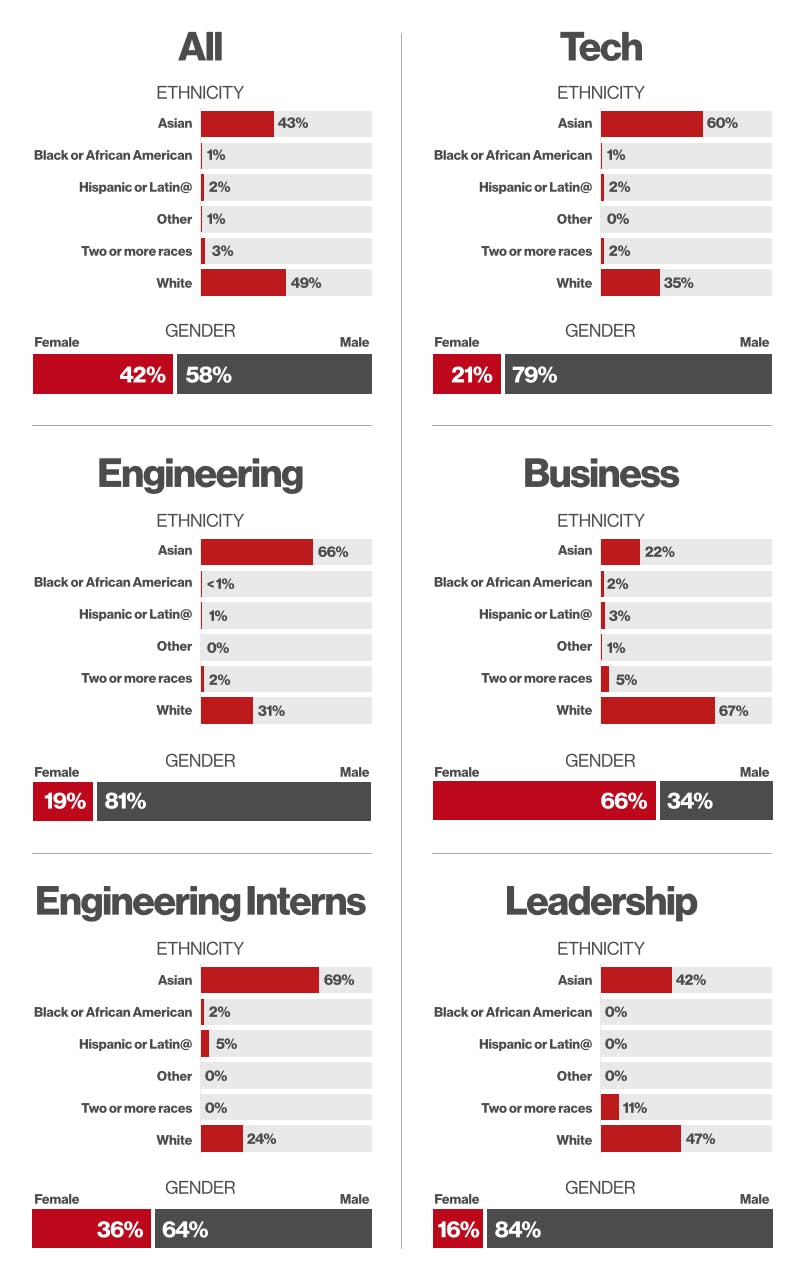If you look at the numbers, the tech industry’s dream of diversity isn’t making much progress.
In an effort to be fully transparent with users and to hold itself accountable, Pinterest just released its hiring goals for 2016.
Pinterest engineer Tracy Chou is largely responsible for elevating the conversation about industry transparency in hiring. Her blog post “Where are the numbers?” went viral in 2013, prompting people to demand tech giants show the racial and gender make up of their companies. Unsurprisingly, most companies that released data (including Google, Facebook, Yahoo, and even Pinterest) were mostly white and male.
Good intentions aside, Pinterest’s efforts appear to have made a minimal impact so far. Female employee numbers grew from 40% to 42% globally, but in engineering, women make up just 19% of the company. Pinterest’s 2016 goals reflect this reality:
Increase hiring rates for full-time engineering roles to 30% female. Increase hiring rates for full-time engineers to 8% underrepresented ethnic backgrounds. Increase hiring rates for non-engineering roles to 12% underrepresented ethnic backgrounds.
Implement a Rooney Rule-type requirement where at least one person from an underrepresented background and one female candidate is interviewed for every open leadership position.
Still, Pinterest’s numbers reflect significantly more female representation than companies like Facebook. In terms of race, that disparity is even greater. In the U.S., Pinterest is just one percent African American, and two percent Hispanic or Latino.
In a blog post, the company acknowledged there is still work to be done. And cofounder Evan Sharp noted that one of the reasons progress remains so slow is that companies neglect to state actionable goals, and how they plan on achieving them. High-level promises without actionable goals do demonstrably little.
One of the reasons progress remains so slow is that companies neglect to state actionable goals, and how they plan on achieving them.
Pinterest is working with Paradigm, an outside diversity consulting agency that helped the company collect diversity data and outline ways for Pinterest to actually improve, beyond just saying that it wants to. In an interview earlier this month, Joelle Emerson, founder of Paradigm, emphasized the role of data in this process.
“Setting goals is really helpful. I don’t want the takeaway to be ‘don’t set goals,’” she said. “A lot of companies are scared to set diversity goals, because they think that implies quotas. But there is a really fundamental difference.”
In addition to its company goals, Pinterest also unveiled a roadmap to achieve them. The company will recruit from more universities and begin an “early identification intern program” that targets students from underrepresented backgrounds; require employees to participate in unconscious bias training; and create a training and mentorship program for black engineers and students, led by a Pinterest engineer who is dedicating 50% of his time to the project.
Pinterest is taking a risk by publishing its internal strategies, because if it fails, the company will be judged for it. But making these goals public is admirable—it ensures transparency and accountability for the things Pinterest claims it wants to do.
“I know companies that are doing a lot of stuff and don’t want to talk about it until they know that it works,” Emerson said. “They don’t want to put out a stamp of approval on this particular strategy until they see the impact. They know they will be held accountable once they say they are using that strategy.”
In publishing this set of goals, Pinterest is setting a new standard of transparency across the tech industry, whether or not it ends up achieving the ideal. And, it helps Pinterest find out what works and what doesn’t in a very public way. Whether other companies will follow suit remains to be seen.
Now that companies have released their workforce statistics, the next question we should be asking is: “What are you doing about it?”
Illustration by Max Fleishman



